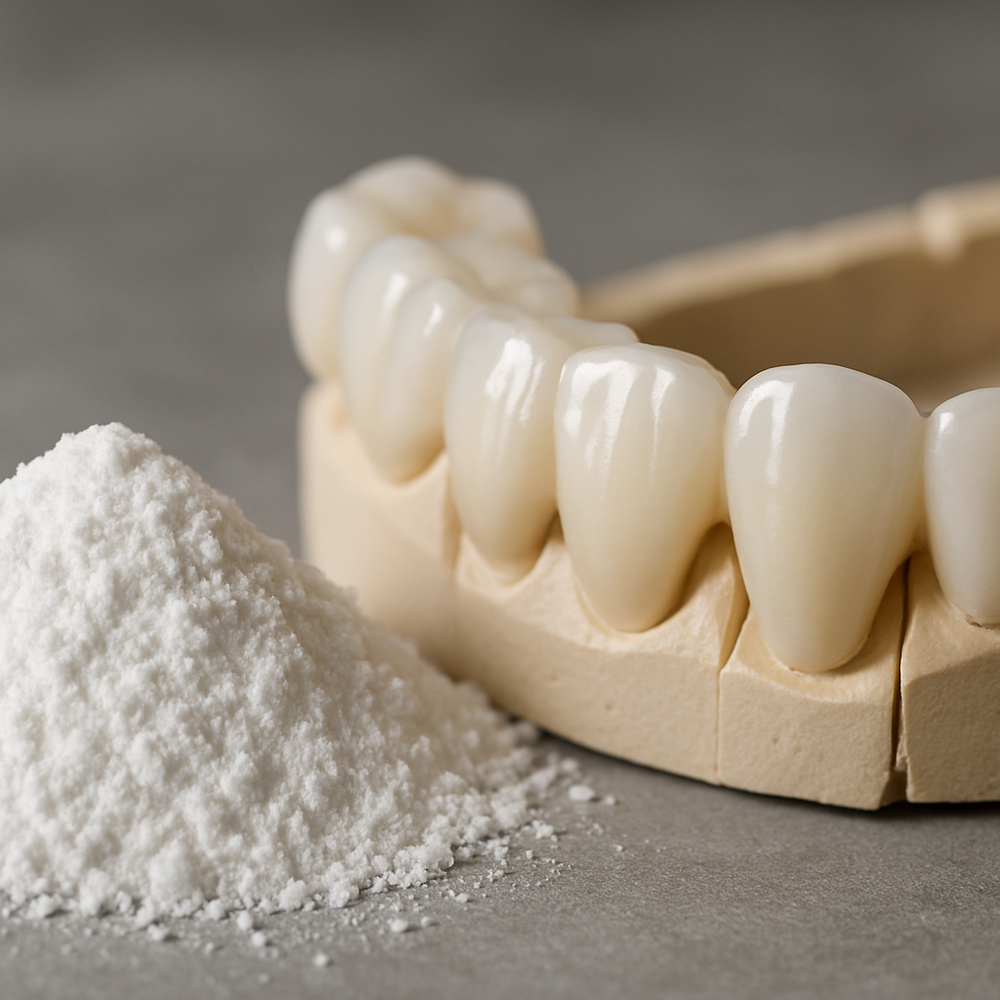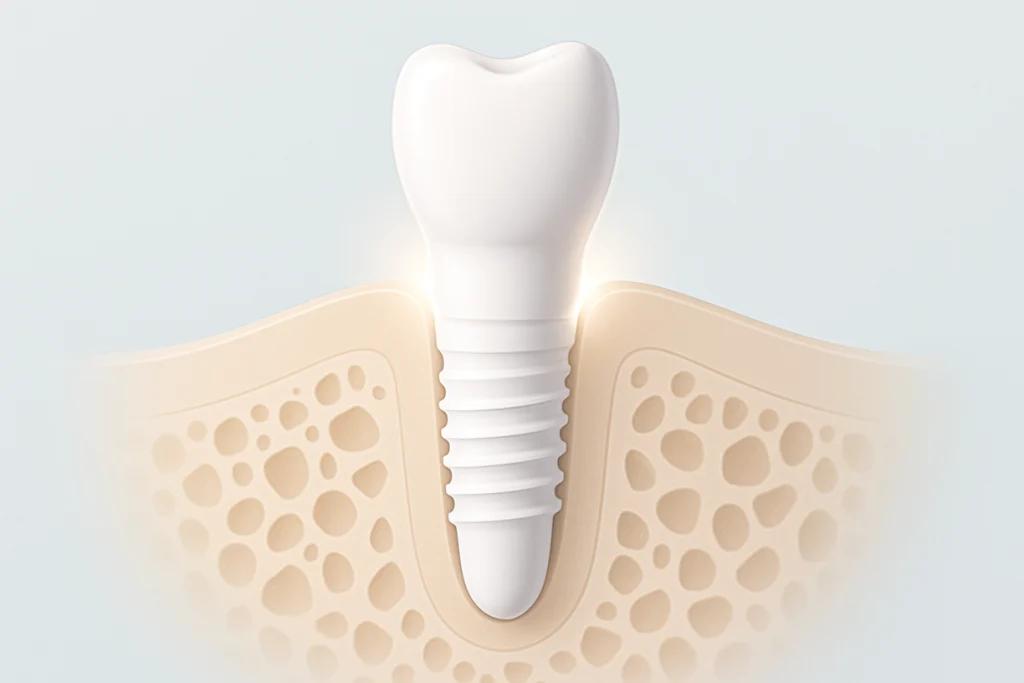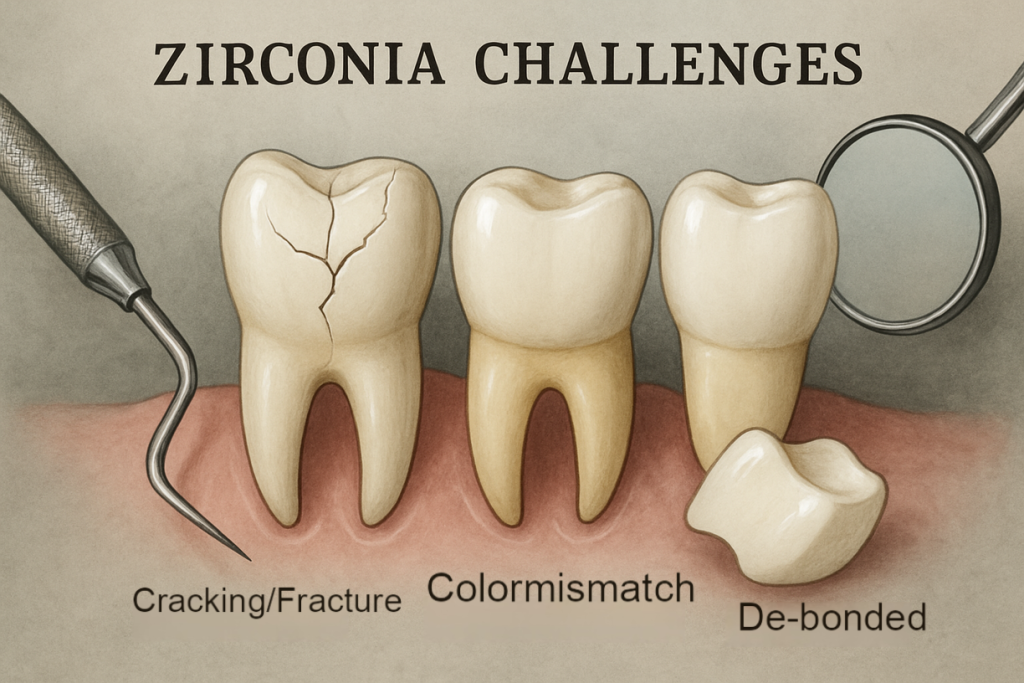In the context of modern dental practices, zirconia powder stands out as a key material with significant benefits. Many dental professionals face challenges when selecting materials for restorations, implants, and crowns. Concerns about durability, aesthetics, and patient comfort are at the forefront of these decisions. This article will address these concerns by explaining what makes zirconia powder so valuable in advanced dental applications. By providing insights grounded in expert knowledge and industry research, we aim to assist dental professionals and purchasing managers in making informed material choices that enhance patient outcomes.

Zirconia powder is essential in creating strong and aesthetic dental restorations.
What Role Does Zirconia Powder Play in Dental Applications?
Zirconia powder is a high-performance ceramic frequently used in various dental applications due to its exceptional properties. Its primary role encompasses serving as a foundational material for several dental components, including crowns, bridges, inlays, onlays, dental implants, and even partial dentures. The outstanding qualities of zirconia make it an appealing choice for these restorations, primarily due to its mechanical strength and excellent aesthetic qualities that can closely mimic natural teeth.
Mechanical Properties: Zirconia’s impressive mechanical strength and toughness are among its most notable attributes. It can withstand substantial bite forces and has superior fracture resistance compared to many other dental materials. This makes zirconia powder a reliable choice for high-stress applications, ensuring that dental restorations can endure the forces of chewing without failure.
Aesthetic Qualities: Aesthetically, zirconia offers a natural translucency that allows it to blend seamlessly with surrounding tooth structures. This quality is particularly beneficial for anterior teeth, where appearance is paramount. Dentists can customize the color and shape of zirconia restorations, providing patients with a more natural look and boosting their confidence in their dental treatment.
Biocompatibility: Another crucial aspect of zirconia powder is its high level of biocompatibility. Unlike some traditional materials, zirconia is less likely to cause adverse reactions in the surrounding tissues, making it a safe option for patients. This property also aids in the healing process, as zirconia allows for a more seamless integration between the implant and bone tissue.
Versatility: Zirconia’s versatility extends beyond traditional applications. For instance, advances in digital dentistry have allowed for the integration of CAD/CAM technology with zirconia milling, enabling practitioners to create highly customized dental solutions quickly and accurately. This capability not only improves the fitting of restorations but also enhances the overall patient experience.
Longevity: When it comes to longevity, zirconia restorations frequently outlast alternatives made from metal or resin. Many patients value long-lasting solutions that require minimal maintenance and fewer replacements. As such, the investment in zirconia restorations is often justified by their durability and lasting performance.
In summary, zirconia powder plays a crucial role in modern dentistry, serving as an essential component for a wide range of applications. Its combination of strength, biocompatibility, aesthetic appeal, and versatility makes it the go-to material for dental professionals aiming to provide high-quality, long-lasting solutions to their patients. The use of zirconia powder enhances not only the technical aspects of dental work but also the overall patient experience, making it a vital material in contemporary dental practice.
Why is Zirconia Powder Preferred for Dental Restorations?
Zirconia powder is increasingly becoming the material of choice for dental restorations. The reasons for this preference lie in both its mechanical and aesthetic properties.
Biocompatibility and durability benefits are significant. Patients with dental restorations often appreciate materials that promote healing and minimize discomfort. Zirconia’s compatibility with bodily tissues contributes to patient satisfaction and promotes successful integration.
Aesthetic advantages also play a critical role. Dental restorations using zirconia closely mimic the appearance of natural teeth, providing a seamless look. This is especially important for visible restorations, where color matching to the surrounding teeth is essential.
Clinical research backs these claims, highlighting that zirconia restorations have lower failure rates than other materials like metal and resin. This not only boosts practitioners’ confidence in their choice but also provides patients with longevity in their dental investments.
Thus, zirconia powder’s combination of durability and aesthetic appeal underscores why it is the preferred material for modern dental restorations.
| Factor | Zirconia | Metal | Resin |
|---|---|---|---|
| Durability | High | Moderate | Low |
| Biocompatibility | Excellent | Moderate | High |
| Aesthetic Appeal | Excellent | Good | Moderate |
| Failure Rate | Low | Moderate | High |
How Does Zirconia Powder Contribute to Implant Success?
Zirconia powder plays an essential role in the success of dental implants. Understanding how it contributes to this outcome requires looking at several key aspects.
First, zirconia is biologically inert, which means it integrates well with bone tissue. This property is critical for the long-term success of dental implants. When patients receive implants made from zirconia, they often experience quicker healing times.
Second, the material’s mechanical strength offers stability during the healing process. This stability is crucial because it helps maintain the position of the implant while the surrounding bone integrates with the material.
Additionally, zirconia is less prone to corrosion, which can be a concern with metal implants. This corrosion resistance means there are fewer chances of failure or adverse reactions, contributing positively to implant success rates.
Moreover, case studies demonstrate that patients with zirconia implants report high satisfaction levels, reinforcing the material’s effectiveness. Dental professionals note that these implants often provide strong functional results and allow for immediate loading in many cases.
To sum it up, zirconia powder significantly contributes to the success of dental implants through its biocompatibility, strength, and corrosion resistance, yielding positive outcomes for both practitioners and patients.

Zirconia implants integrate well with bone, ensuring successful outcomes.
What Specific Properties Make Zirconia Powder Ideal for Crowns?
Zirconia powder’s unique properties make it an excellent choice for dental crowns.
Strength and fracture resistance are among the primary advantages. Zirconia is one of the toughest dental materials available, withstanding significant bite forces that might cause failures in weaker materials.
Another useful feature of zirconia crowns is their lack of translucency issues. Unlike metal, zirconia crowns can be customized to match tooth color accurately. This aesthetic benefit enhances their appeal, especially for anterior teeth where appearance is crucial.
Additionally, zirconia’s thermal properties offer comfort to patients. Traditional materials often conduct heat and cold, leading to sensitivity. Zirconia minimizes this effect, providing a more comfortable experience for those with crowns.
Lastly, the longevity of zirconia crowns contributes to their growing popularity. With proper care, these crowns can last many years without needing replacement, providing long-term value both to dental professionals and patients.
Key Properties of Zirconia for Crowns:
- High fracture toughness
- Excellent aesthetics
- Minimal thermal conductivity
- Long-term durability
- Chemical resistance
In summary, the properties of zirconia powder—strength, aesthetics, and thermal comfort—solidify its position as the ideal choice for durable and attractive dental crowns.
| Property | Zirconia | Metal | Porcelain |
|---|---|---|---|
| Strength | Very High | Moderate | Low |
| Translucency | Low | High | High |
| Thermal Conductivity | Low | High | Moderate |
| Longevity | Long-lasting | Moderate | Short |
How Does Zirconia Powder Affect Patient Satisfaction?
Patient satisfaction is crucial in dentistry, and zirconia powder plays a notable role in enhancing this experience.
Aesthetic outcomes positively impact how patients feel about their dental work. Restorations using zirconia often look more like natural teeth compared to metal options. Patients appreciate the seamless appearance, especially in visible areas.
Comfort is another factor. Many patients report that zirconia restorations are more comfortable than their alternatives. The material’s smooth finish and natural feel contribute to a better overall experience during functions like eating and speaking.
Furthermore, zirconia’s long lifespan provides peace of mind. Patients are less likely to worry about replacements or repairs, knowing their crowns and implants can last many years. This reliability fosters trust in dental care providers.
Surveys and studies reveal that patients favor zirconia restorations for both aesthetic and practical reasons. This trend reveals a shift towards using zirconia among younger generations who prioritize longevity and social acceptance in their dental appearance.
Overall, zirconia powder directly affects patient satisfaction through its aesthetic qualities, comfort, and durability, making it a wise choice in dental practices.
What Innovations are Emerging for Zirconia Powder in Dentistry?
As technology advances, so do the applications of zirconia powder in dentistry. Ongoing innovations are enhancing performance and utility.
New techniques in manufacturing zirconia products lead to improved material strength and aesthetics. Recent developments include enhanced sintering processes, resulting in denser restorations with better durability.
Digital dentistry is another area experiencing growth. The integration of CAD/CAM in zirconia restoration production allows for precise designs tailored to individual patient needs, enhancing both functionality and aesthetic outcomes.
Additive manufacturing is also on the rise. This technology enables the creation of complex zirconia structures that were previously challenging to manufacture. As a result, dental professionals can offer even more customized solutions.
Research into bioactive zirconia is advancing as well. Scientists are exploring ways to make zirconia materials that actively promote bone regeneration. This innovation could further improve implant success rates and patient outcomes.
Emergent Innovations in Zirconia Dentistry:
- Enhanced sintering techniques
- Precision-driven CAD/CAM applications
- Advanced additive manufacturing methods
- Development of bioactive zirconia materials
To conclude, the field of zirconia powder in dentistry is evolving. Continued advancements in manufacturing and digital applications promise to expand its use in new and innovative ways.
| Innovation Area | Description | Impact |
|---|---|---|
| Manufacturing Techniques | Enhanced sintering | Improved strength and aesthetics |
| Digital Dentistry | Use of CAD/CAM | Customization and precision |
| Additive Manufacturing | Complex structures | Innovative designs |
| Bioactive Research | Promoting bone regeneration | Increasing implant success rates |
How is Zirconia Powder Processed for Dental Use?
The processing of zirconia powder for dental use involves several detailed steps to ensure quality and performance.
The initial step is material sourcing, where high-purity zirconium oxide is selected. This ensures the final product is free from impurities that could compromise its integrity.
Next is the sintering process. During sintering, zirconia powder is heated at high temperatures to form a solid structure. This stage is critical as it determines the mechanical strength and toughness of the final product.
Quality control measures follow the manufacturing process. Each batch undergoes rigorous testing to evaluate properties like strength and biocompatibility. Using statistical process control (SPC), manufacturers can maintain consistency across products.
Finally, finishing processes provide the desired aesthetics. This might include polishing and coloring to achieve the proper shade matching with natural teeth.
In summary, the meticulous processing of zirconia powder—from sourcing through quality control—ensures that dental applications exceed performance expectations.
What Are the Cost Implications of Using Zirconia Powder?
The decision to use zirconia powder involves weighing cost implications against benefits.
Cost versus benefits analysis shows zirconia may have a higher upfront cost compared to traditional materials. However, considering its durability and longevity, the overall investment often pays off over time. Routine replacements and repair costs can add up significantly for materials with shorter lifespans, making zirconia a more economical choice in the long run.
Treatment outcomes also justify the investment. Higher success rates with zirconia restorations mean fewer patient callbacks for corrective work.
Insurance coverage varies by provider, but many insurance plans recognize the value of zirconia restorations. This can mitigate costs for patients and practitioners alike.
Factors Affecting Cost Implications:
- Material sourcing and purity
- Manufacturing processes
- Long-term maintenance and replacement
- Insurance reimbursement levels
Ultimately, while zirconia powder might require a greater initial investment, it often leads to savings through longevity, fewer replacements, and heightened patient satisfaction.
| Cost Factor | Zirconia | Metal | Resin |
|---|---|---|---|
| Initial Cost | High | Moderate | Low |
| Longevity | Long-lasting | Moderate | Short |
| Failure Rates | Low | Moderate | High |
| Insurance Coverage | Variable | High | Low |
How Can Dental Professionals Educate Patients About Zirconia?
Educating patients about zirconia powder is essential for informed decision-making. Dental professionals can employ various strategies.
Effective communication strategies begin with understanding patients’ needs and concerns. Actively listening is crucial to address any misunderstandings about the material.
Utilizing visual aids can assist in conveying complex information. For example, charts comparing the benefits of zirconia to other materials can illustrate its advantages vividly.
Resource materials, such as brochures or videos, can also aid in educating patients about the properties of zirconia. These materials should highlight its strength, appearance, and comfort, addressing common concerns.
Consider implementing educational events in your practice. Hosting informational sessions allows patients to ask questions in a relaxed environment. Sharing testimonials from satisfied patients can also build trust and demonstrate real-world benefits.
In conclusion, educating patients on the use of zirconia powder is vital to enhancing their understanding and confidence in their dental choices.
What Challenges are Associated with Zirconia Powder in Dental Practice?
While zirconia powder has numerous advantages, it also comes with certain challenges in dental practice.
Common issues faced by dental professionals include the difficulty of adjusting zirconia restorations. Due to their hardness, modifying the material can require specialized tools, which some practitioners may not have readily available.
Another challenge relates to initial costs. As highlighted previously, while the long-term benefits justify the investment, the upfront expense may deter some practices from adopting zirconia.
Training is also essential. Staff must be adequately educated on zirconia properties and processing techniques to provide optimal patient care. This may require investment in additional training sessions or resources.
To mitigate these challenges, dental practices can develop a standard protocol for zirconia use. Keeping abreast of advancements in zirconia technology and processing can also help practices remain competitive.
Potential Challenges of Using Zirconia:
- Tooling requirements for adjustments
- Higher initial costs
- Staff training on material properties
- Competition with lower-cost solutions
Ultimately, recognizing and addressing these challenges can ensure that zirconia powder is utilized effectively within dental practices.

Understanding the challenges of zirconia usage helps improve dental practices.
Conclusion
In this article, we explored the importance of zirconia powder in advanced dental applications. Key insights include its unparalleled strength, aesthetic appeal, and significant impact on patient satisfaction. By choosing zirconia, dental professionals can provide durable and attractive solutions that enhance patient care. Partner with Global Industry to leverage our expertise in zirconia applications for your practice. For more information or personalized advice, visit our website or contact us directly.
FAQ Section
Q1: What are the benefits of zirconia powder in dentistry?
Zirconia powder offers several exceptional benefits for dental applications. It possesses high strength and durability, making it ideal for crowns, bridges, and implants. Additionally, its excellent aesthetic properties allow for a natural appearance, which is crucial for visible restorations. Zirconia is also biocompatible, meaning it integrates well with human tissues and minimizes the risk of allergic reactions. Its resistance to wear and corrosion further enhances its longevity, making it a reliable choice for dental restorations.
Q2: How does zirconia powder compare to other dental materials?
When compared to traditional materials like metal and resin, zirconia stands out due to its superior mechanical properties and aesthetics. Zirconia offers greater strength, making it less prone to fractures compared to ceramic options. Unlike metal, zirconia does not create a visible dark line at the gum line, providing a more natural look. It is also less susceptible to temperature sensitivity than porcelain, leading to increased patient comfort. Ultimately, these advantages contribute to better long-term outcomes and patient satisfaction.
Q3: Is zirconia powder safe for dental use?
Yes, zirconia powder is considered highly safe for dental applications. It is extensively tested for biocompatibility, showing minimal risk of allergic reactions or irritation to the surrounding tissues. Many dental practitioners prefer zirconia due to its inert nature, which means it does not react negatively with the body. This safety profile, combined with its durability, makes zirconia a trusted choice for various dental procedures, including implants and crowns.
Q4: What maintenance is required for zirconia dental work?
Maintaining zirconia restorations is relatively straightforward. Patients are advised to follow standard dental hygiene practices, including regular brushing and flossing, just as they would with natural teeth or other dental materials. Routine dental check-ups are essential to monitor the health of the surrounding gum tissue and confirm that the restoration remains in good condition. Unlike some traditional materials, zirconia does not require special cleaning techniques, making it convenient for patients.
Q5: Are there any downsides to using zirconia powder?
While zirconia has numerous advantages, there are some challenges associated with its use. The initial cost of zirconia restorations may be higher than traditional materials, which can deter some patients and practices. Additionally, due to its hardness, modifying zirconia restorations (when adjustments are necessary) can be challenging and may require specialized equipment. Moreover, practitioners need to be adequately trained to use zirconia effectively in their practice. These considerations are essential to weigh against the long-term benefits and success that zirconia offers.
